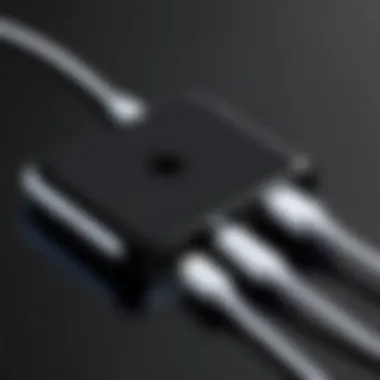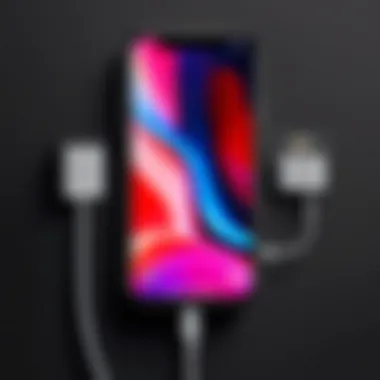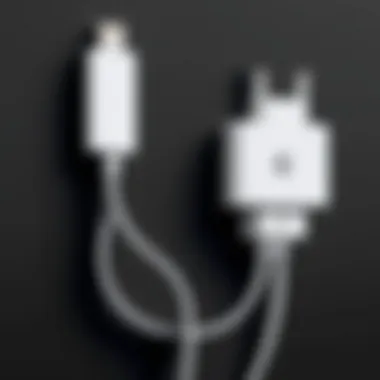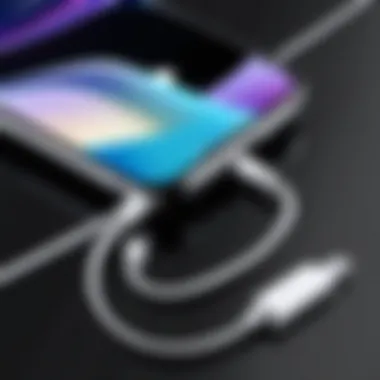Ultimate Guide to iPhone 11 Cord Adapters and More


Intro
The evolution of smartphone technology has brought about a significant shift in how users engage with their devices. The iPhone 11, known for its powerful performance and sleek design, also relies on a variety of cord adapters to enhance its functionality. Given the attributes of modern electronics, understanding cord adapters is essential for maximizing the usability of the iPhone 11. This guide aims to delve into the intricacies of iPhone 11 cord adapters, exploring their specifications, compatibility, and practical applications.
Technical Specifications
Detailed Product Specs
Cord adapters for the iPhone 11 come in various types, each designed for specific uses. From lightning to USB-C adapters to audio jack accerssories, these adapters vary significantly in terms of technical precision. Users must understand the specific details to make informed choices. The lightning adapter typically supports both charging and data transfer. Specs like a 480 Mbps data transfer rate are common, while charging speeds can range based on adapter type.
Performance Metrics
Performance metrics for cord adapters are vital. They can influence charging speed and data transfer capabilities. For instance, a high-quality adapter like Apple's Lightning to USB Camera Adapter can transfer photos at 480 Mbps. In contrast, cheaper or unbranded alternatives might offer reduced speeds and unreliable connections. Checking for MFi certification can ensure that an adapter meets Apple standards for performance and safety.
Compatibility Information
Compatibility is another crucial aspect. Not all cord adapters work seamlessly with the iPhone 11. It is important for users to verify that the adapters support iPhone 11's software and hardware architecture. For example, certain adapters may not function with iOS updates or may lack support for advanced features like fast charging.
Product Comparisons
Feature Comparisons
When selecting an adapter, comparing features is essential. For instance, a Lightning to USB adapter may differ in supported features compared to a Lightning to HDMI adapter. Some adapters offer additional ports for diverse usage scenarios, while others are single-function.
Price Breakdown
The price range for cord adapters can vary greatly. High-end options, such as those from Apple, typically fall in the $20 to $50 range. Meanwhile, generic versions might be available for $5 to $15 but often sacrifice quality and reliability. Investing in a pricey adapter could save time and trouble in the long run.
User Experience Breakdown
User reviews often reveal insights into the performance of specific adapters. Brands that consistently receive positive ratings include Apple and Anker. Lesser-known brands could have mixed reviews, especially concerning durability and performance.
Practical Applications
Use Cases for Different Users
Different users will have varying needs concerning cord adapters. Gamers often require low-latency connections for peripherals, while professional photographers may prioritize fast data transfer for large files. Everyday users might only need adapters for charging or audio.
Recommended Configurations
For optimal use, a combination of adapters may benefit many users. For instance, pairing a lightning to HDMI adapter with a high-speed charging cable ensures multimedia needs are met while maintaining battery health.
Multi-Platform Performances
Adapting across platforms is common in today’s tech landscape. Users might need iPhone 11 cord adapters that work not only with Apple products but also with a variety of other devices. Always check the specifications to ensure compatibility across different brands.
Latest Trends
Industry Developments
The tech industry continues to innovate, and cord adapters for smartphones are no exception. The trend is shifting toward enhanced compatibility and enhancements in data speeds. Wireless adapters are becoming more common, driven by consumer demand for convenience.
Emerging Technologies
Emerging technologies such as USB Power Delivery are influencing the design and performance of modern cord adapters. This tech allows for faster charging and greater efficiency in data transfer.
Future Predictions
It is expected that the market for iPhone 11 cord adapters will expand as new models are introduced. Anticipated advancements include better integration with smart home devices and advancements in wireless technology.
Buying Guides
Recommended Products
When considering a purchase, sought-after products include the Apple Lightning to USB Adapter and Belkin’s Lightning Audio Adapter. These options ensure quality and performance.
Purchasing Tips
Before buying, always verify customer reviews and product specifications. Seeking out MFi-certified products can also enhance reliability and performance.


Warranty and Support Information
Several brands offer warranties and customer support. Apple generally provides one year of warranty on its accessories, giving consumers a sense of security in their investment. Selecting brands with good customer service can also assist with any practical issues that arise.
Prolusion to iPhone Cord Adapters
In today’s digital age, utilizing the right technology ensures that our devices work efficiently. iPhone 11 cord adapters play a crucial role in compatibility and functionality across a range of devices. As smartphones evolve, the necessity for adapters that can bridge the gap between different technologies emerges. These connectors offer more than mere convenience; they expand the usability of your iPhone 11 in various contexts.
Adapters do something important. They allow users to connect different devices. Without them, users may feel limited. For instance, using modern headphones with a classic audio jack or linking an iPhone to a larger screen can be difficult without the correct adapter. These accessories are not just extra items; they facilitate a more versatile digital experience, allowing for smooth operation among varied platforms.
Understanding the Need for Adapters
With the iPhone 11, many users find they cannot connect to older audio devices or televisions directly. This lack of direct connectivity highlights the importance of adapters in today’s tech landscape. Apple’s decision to remove the traditional audio jack serves as a reminder of the ongoing shift towards wireless technology. However, many still rely on wired connections for charging or audio.
Key points regarding adapters include:
- Connecting Legacy Devices: Older devices may not be designed for newer technology. Adapters solve this problem by linking the older technology to newer gadgets.
- Enhancing Functionality: Quick access to various types of connections without needing to buy new devices can save users money and frustration.
- Fostering Versatility: Adapters allow users to transition between different technologies seamlessly, creating an adaptable digital environment.
As the demand for different connections increases, so does the need for efficient solutions. Whether it's charging your phone or streaming videos, having the right adapter enhances your device’s capability.
The Evolution of Charging Technology
The landscape of charging technology has changed dramatically over the years. Initially, charging ports were bulky and cumbersome, often requiring specific chargers filled with proprietary technology. Now, with developments in standards like USB-C and the widespread adoption of Lightning connectors, charging has become more streamlined.
Significant shifts occur every few years, paralleling advancements in smartphone design and functionality. In the case of the iPhone 11, fast charging and user accessibility are top priorities. The innovations bring benefits such as:
- Faster charging times: Using the right adapter maximizes energy transfer rates.
- Universal compatibility: More streamlined connectors mean easier access across devices.
- Durable materials: Quality adapters are designed to withstand wear and tear, increasing their lifespan.
The evolution signifies not only a technical advance but also a user-centric approach. In an ever-connected world, these changes facilitate a superior experience, making it essential to stay informed about available adapters.
Types of Cord Adapters for iPhone
Cord adapters are crucial components when using an iPhone 11. They provide versatility and functionality that enhance the user experience. Understanding the different types of adapters available allows consumers to make informed choices tailored to their specific needs. This section dives into the various cord adapters, explaining their purposes, benefits, and considerations.
Lightning to USB Adapter
The Lightning to USB adapter is one of the most essential accessories for the iPhone 11. It enables users to connect their devices to a computer or a USB power source. This adapter is beneficial for data transfer as well as charging. By using this connection, one can quickly sync their iPhone with a computer, ensuring that data backups and updates are efficient.
Key features include:
- Allows fast data transfer between devices.
- Supports high-speed charging.
- Compatible with various USB devices, enhancing its utility.
Ensuring compatibility with other devices is vital. For example, some USB devices may not provide enough power or may need specific drivers.
Lightning to 3.
mm Headphone Jack Adapter
As iPhones moved away from conventional audio jacks, the Lightning to 3.5 mm headphone jack adapter became increasingly important. This adapter allows users to connect their traditional headphones or audio devices to the iPhone 11. With it, users can listen to music or take calls with their preferred audio gear.
Benefits of this adapter include:
- Retain use of legacy audio devices while enjoying new technology.
- Enhanced audio quality without compromise, maintaining sound fidelity.
- Easy to carry, as it is compact and lightweight.
Given the audio industry's evolution, this adapter ensures that users are not forced to buy new headphones, saving money and resources.
Lightning to HDMI Adapter
The Lightning to HDMI adapter offers a significant advantage for users who want to share their iPhone 11's screen with larger displays. This adapter allows connections to TVs, projectors, and monitors. It is particularly useful for presentations, movies, or any media sharing.
Features include:
- Supports 1080p HD video output, ensuring a great viewing experience.
- Plug-and-play setup, making it user-friendly.
- Compatibility with a range of HDMI devices.
When considering this adapter, it's important to check the compatibility of the display device to ensure optimal performance. The seamless transition from portable devices to larger screens can greatly enhance entertainment or work experiences.
The versatility of iPhone 11 cord adapters plays a vital role in enhancing device functionality, giving users more ways to connect, share, and enjoy their digital content.
Compatibility Considerations


When it comes to iPhone 11 cord adapters, compatibility is a crucial aspect to contemplate. The ability to effortlessly connect various devices and accessories enhances user experience and functionality. This section will delve into the importance of ensuring device compatibility and the differences between third-party adapters and Apple MFi certified options.
Ensuring Device Compatibility
One of the primary considerations in selecting a cord adapter is ensuring that it is compatible with your iPhone 11. Not all adapters are designed equally, and using an incompatible adapter may result in poor performance or even damage to your device.
Key Elements of Compatibility:
- Connector Type: The iPhone 11 utilizes a Lightning connector, so any adapter must adhere to this standard.
- Operating System Support: Ensure the adapter supports iOS updates. Some third-party adapters may not function properly with the latest iOS versions.
- Device Interaction: Check for compatibility with other devices you own. For instance, if you plan to use your iPhone 11 with a specific set of headphones, verify that the adapter allows for audio transmission.
Verifying compatibility not only safeguards your device but also ensures seamless integration with peripherals, enhancing overall functionality and convenience.
Third-Party vs.
Apple MFi Certified Adapters
The market offers a vast array of adapter choices, including those made by Apple and numerous third-party manufacturers. This creates a dichotomy in consumer choices, where price versus quality often becomes a point of discussion.
Apple MFi Certified Adapters:
These adapters meet Apple's stringent quality and performance standards. Key benefits include:
- Guaranteed Compatibility: MFi certified products are specifically designed to work with Apple's ecosystem.
- Consistent Performance: They offer reliable data transfer rates and charging capacity, minimizing the risk of failure.
- Assured Quality: Apple’s certification ensures a level of durability and longevity in use.
Third-Party Adapters:
While often more affordable, the quality and compatibility of third-party adapters can vary widely. Considerations include:
- Price Point: Many consumers are attracted by the lower price tag, but this could lead to issues.
- Uncertainties in Quality: Some third-party options may not support all features, leading to potential drawbacks, particularly with audio output and charging speed.
- Lack of Support: If a third-party adapter fails, customers may not have access to the same level of support as with MFi certified products.
Choosing between these options requires careful consideration, balancing budgetary constraints against guaranteed performance and durability.
Technical Specifications of iPhone Cord Adapters
Understanding the technical specifications of iPhone 11 cord adapters is crucial for users who want to optimize their device's performance. These specifications dictate how effectively an adapter can transfer data, deliver power, or connect to various devices. Choosing the right adapter that meets your requirements can greatly enhance your overall user experience.
Data Transfer Rates
Data transfer rate refers to the speed at which information can be sent between devices. For iPhone 11 cord adapters, this specification is essential for tasks that involve moving files such as photos, videos, or music. A higher data transfer rate means less waiting time during these processes.
Adapters like the Lightning to USB adapter typically support USB 2.0 speeds, allowing data to transfer at rates up to 480 Mbps. If you're working with high-resolution video or large amounts of data, this speed may affect the efficiency, as waiting for transfers to complete can be frustrating. Evaluating the appropriate lightning adapter with the right data transfer capability can make a notable difference in productivity.
- Key Considerations:
- For tasks requiring quick access to large files, choose adapters with high transfer rates.
- Assess your work habits to determine if high-speed transfer is necessary.
Charging Capabilities
Charging capabilities of an adapter reveal how efficiently it can replenish your iPhone 11's battery. Adapters differ in their power output, measured in watts, thus influencing how fast your device charges. For instance, Apple’s Lightning to USB-C adapter supports fast charging. When using a compatible USB-C power adapter with it, iPhone 11 can reach approximately 50% charge in around 30 minutes.
Understanding these charging specifications ensures that users select adapters that align with their need for speed in charging their devices. It is essential to note that while higher wattage can lead to faster charging, compatibility with your iPhone model must also be considered to avoid potential damage.
- Points to Remember:
- Use suitable charging cables to match your adapter's output for optimal charging effectiveness.
- Be aware of your adapter’s wattage and your iPhone's charging capacity to determine the ideal charging set up.
"Choosing the right adapter not only enhances device usability but also plays a pivotal role in prolonging the life of your device."
User Considerations
User considerations play a crucial role when selecting cord adapters for the iPhone 11. Understanding how these devices affect overall user experience can lead to informed decisions. The primary areas of focus include device performance and durability. Each of these aspects contributes significantly to the satisfaction of the user as they interact with their devices on a daily basis.
Impact on Device Performance
Effects of Adapter on Charging Speed
When considering how an adapter influences charging speed, it's important to recognize the type of charging technology that the adapter supports. The Lightning cable, when used with compatible adapters, can enable fast charging. Many third-party adapters may not support this capability, leading to longer charging times. Speed is a key characteristic in this context.
Using a high-quality adapter translates to quicker charge times, which is beneficial for users on the go. Unique features to look for include support for Power Delivery, which significantly enhances charging efficiency. However, not all adapters provide this benefit, which may lead to potential downsides if you choose a lesser option. Paying attention to these characteristics can ensure an optimal charging experience.
Audio Quality with Adapters
The audio quality is another critical aspect when using adapters, particularly the Lightning to 3.5 mm headphone jack adapter. This adapter allows users to connect traditional headphones to their iPhone 11 without direct Lightning compatibility. The key characteristic here is sound fidelity. Users often seek adapters that do not compromise audio quality compared to direct connections.


Some adapters may introduce noise or distortion, affecting the listening experience. Selecting a well-reviewed adapter ensures that sound quality remains high, preserving the music’s clarity and depth. Aspects such as compatibility with various audio formats are vital, particularly for audiophiles. Therefore, understanding these audio traits will influence a user’s choice significantly.
Durability and Build Quality
Durability and build quality are paramount when choosing any electronic accessory. Cord adapters can undergo frequent plugging and unplugging, leading to wear and tear over time. Adapters with reinforced connectors tend to last longer, making them a sensible choice for daily use.
The materials used in the adapter construction also impact longevity. Plastic components may wear out quickly, while metal or high-grade polymer options are typically more resilient. Evaluating the build quality of an adapter can save users from future inconveniences and additional expenses in replacements. Ensuring a good balance between performance and durability will ultimately lead to better user satisfaction.
Choosing the Right Adapter
Choosing the appropriate cord adapter for your iPhone 11 is more than a simple decision of personal preference. It plays a crucial role in how effectively your device operates in varying environments. Selecting the right adapter not only enhances functionality but also assures a seamless connection to other devices. The complexity of different specifications and compatibility requirements can confuse many users. However, understanding personal needs and the distinct features of the adapters available on the market can lead to a more informed choice.
Assessing Personal Needs
Understanding your personal requirements is essential when pinpointing the right cord adapter. Different functionalities cater to different scenarios.
- Frequency of Use: Reflect on how often you use specific features like audio or video output. If you frequently listen to music, a Lightning to 3.5 mm headphone jack adapter might be critical.
- Device Interaction: Consider which devices you regularly connect to your iPhone 11. A Lightning to HDMI adapter would be beneficial if you often mirror screens for presentations or entertainment.
- Travel Requirements: For those who travel, smaller and multi-functional adapters can save space and reduce the number of cables you carry.
Before making a purchase, reflect on how you utilize your device daily. This reflection aids in identifying what specifications are most essential to you.
Comparative Analysis of Top Adapters
In the market, various cord adapters exist, each with distinct advantages and drawbacks. To make an informed decision, analyzing a few top contenders serves a significant purpose.
- Apple Lightning to USB Adapter
This adapter is perfect for those who prioritize reliability. It offers compatibility with various USB devices and assures stable connectivity. - Apple Lightning to 3.5 mm Headphone Jack Adapter
Great for users still fond of traditional audio methods. It may not support all third-party headphones, so checking compatibility before purchasing is necessary. - Apple Lightning to HDMI Adapter
Ideal for presenting or streaming content. While it supports 1080p video, it requires a cable to be plugged into a power source to function correctly. - Anker Lightning to USB-C Adapter
Known for its durability, this adapter provides fast charging capabilities but may not support audio output. - Belkin Lightning to 3.5 mm Audio Adapter
This product serves as a good alternative to Apple's official adapter. However, reports of varying audio quality have been noted, warranting personal testing by users.
When selecting an adapter, remember to consider performance, durability, and how well it meets your needs.
In summary, taking time to assess personal needs and evaluating top options can enhance your iPhone 11 experience significantly.
Where to Purchase Cord Adapters
When it comes to purchasing iPhone 11 cord adapters, where you buy matters significantly. The market is flooded with options, each having distinct advantages and potential drawbacks. Understanding these can enhance your buying experience and ensure you receive a high-quality product without overpaying.
Authorized Retailers vs.
Online Marketplaces
Authorized retailers are often the go-to option for consumers seeking assurance. Brands like Apple and other certified providers generally offer products that meet stringent quality standards. This means you are more likely to find products that are MFi certified, ensuring compatibility with your iPhone 11. In contrast, online marketplaces such as Amazon may offer a wider variety of options, including third-party brands that can be less expensive. It is crucial to research the vendor's reputation and read customer reviews to avoid potential pitfalls.
- Advantages of Authorized Retailers:
- Drawbacks of Online Marketplaces:
- Higher assurance of quality and compatibility.
- Access to customer service for returns or inquiries.
- Ability to physically inspect the product before buying.
- Risk of purchasing counterfeit or non-MFi certified products.
- Variable shipping times and return policies.
Ultimately, your choice may depend on immediate needs and whether you prioritize quality over cost.
Price Comparisons and Value Assessment
Conducting a price comparison is essential when purchasing adapters. Prices can vary widely between retailers, and therefore, evaluating the value is just as important as the initial price tag. Websites like PriceGrabber or ShopSavvy can help you compare prices across different platforms.
When assessing value, consider:
- Quality of the Adapter: A cheaper adapter may save money initially but could lead to performance issues or device damage in the long run.
- Warranty and Support: Some adapters offer warranties, which can translate into savings if they malfunction.
- Long-Term Usability: Will the adapter meet future needs as technology evolves?
To ensure you make a well-informed decision, reflect on your unique needs and do thorough research.
Always read reviews and check ratings for better insight into the performance of the adapter.
Purchasing cord adapters should balance quality, price, and your individual needs. Taking the time to explore each option will yield the best outcome, optimizing your iPhone 11 experience.
Culmination
The discussion about iPhone 11 cord adapters is significant for many users who strive for enhanced device performance. These adapters are not mere accessories; they bridge various functionalities and enable consumers to expand how they use their iPhone. Understanding the nuances of each adapter type enhances user experience. It also leads to better compatibility decisions that can affect both functionality and device longevity.
Summarizing Key Points
In summarizing the key points discussed, it is clear that:
- Types of Adapters: Several types of iPhone 11 cord adapters exist, including the Lightning to USB and Lightning to HDMI, each serving unique purposes in functionality.
- Compatibility Considerations: Ensuring the adapter’s compatibility with other devices is crucial. Apple’s MFi certification is a significant factor when considering third-party options.
- Technical Specifications: Knowledge about data transfer rates and charging capabilities affects user choices. Higher rates contribute to better performance.
- User Considerations: The impact on device performance, including charging speed and audio quality, cannot be overlooked. Users should evaluate the durability of products as well.
- Purchasing Options: Authorized retailers may offer an advantage in terms of product reliability. Pricing strategies between these and online marketplaces vary significantly as well.
Future of iPhone Adapters
The future of iPhone adapters appears to be influenced largely by technological advancements. As charging ports evolve, adapters must adapt accordingly. Innovations in wireless technology could potentially minimize the reliance on physical adapters, promoting convenience and reducing clutter. However, demand for specific functionalities, such as audio output and video streaming, indicates that cord adapters will maintain relevance in the near term.
Overall, keeping abreast of trends in adapter technology can lead to better choices in the evolving landscape of mobile devices.







